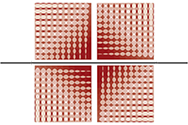

As any creative professional will tell you, the portfolio is the keystone of any designer's career. Unless one has the enviable fortune to engage the entirety of one's professional life within a single design firm, the portfolio will loom perpetually as both the greatest opportunity to showcase one's talent and the harbinger of inevitable formatting nightmares. The portfolio is a designer's visual identity. It is the tool by which a designer's style and design sensibilities are communicated and measured. The portfolio is a living document that is intended to change with the experiences of the designer. Its quality can make or break an application and career trajectories are often beholden to the strength of the portfolio. ...
That being said, it is generally recognized that portfoilios have their practical limitations, especially when considering file size, length, and customary content. A portfoilio, in its most conventional usage, is expected to represent the best of the designer's capabilities and tell a cohesive (yet brief) story. But what happens to those back of the napkin sketches that never quite make it past concept? Where should a designer's penchant for generating visual inspiration pieces be expressed when the art itself is unrelated to a particular project? So much of what we do as designers are unfinished thoughts: the unselected alternatives that aren't reflected in the final visuals, the abandoned designs, the sacrificed elements in the name of value-engineering or the capricious nature of industry trends.
My answer to this reality of the design profession is the digital repository, the virtual equivalent to a physical filing cabinet. A personal digital repository provides an organizing framework for designed content with fewer constraints than the digital portfolio. It is the inherent flexibility of the digital repository that enables the most accurate reflection of the breadth of a designer's skillset, unemcumbered by project narrative or requirement for brevity.
Welcome to my digital repository! Peruse at will and enjoy your visit.

RETAIL STORE PROJECTS
(SALES FLOORS & STOCKROOMS)
FOOD SERVICE PROJECTS
(CAFES & KITCHENS)
THEATER PROJECTS
(TICKETING & CONCESSIONS)
WORKPLACE PROJECTS
(OFFICES & FACILITIES)
As a supervisory-level design professional, I am committed to leveraging my unique career path and project experience spanning interior design, architecture, management consulting, and civil engineering in the planning, design, and construction of innovative and contextually-sensitive built environments.
Multiple sectors including retail, food & beverage, workplace, entertainment, and residential design. Master of Arts in Interior Design. NCIDQ certified.
Mixed-use architecture and prototype customization. Bachelor of Arts in Design of the Environment.
Civil engineering, land planning, and site design. Bachelor of Science in Civil Engineering.
Planning, program management, documentation coordination, procurement, information systems assessment, integrated technologies, and customer relationship management.